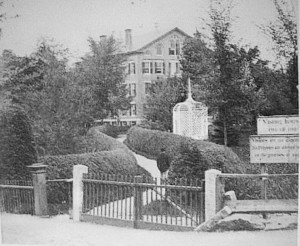New years may imply fresh starts, but for the superintendent of the Canton Asylum for Insane Indians, a new year often meant the same old–or brand new–problems to deal with. The asylum was inspected by Supervisor Jacob Breid in January, 1912. A new sewer had just been completed, but did not work; water was not flowing correctly through one of the manholes about 1,500 feet away from the buildings. Continue reading
Category Archives: BIA Bureau of Indian Affairs
Food Scarcity

Cheyenne-Arapaho Ration Card Used During the Time of the Land Run, courtesy Oklahoma Historical Society
Winter had always been a time of scarcity for both agricultural and nomadic peoples. Even when crops were good and supplies safe, winter generally meant fewer food choices and dwindling stores of edibles that could not be replenished until spring arrived.
Native Americans faced extreme threats to their food supply by the twentieth century: Continue reading
Winter As a Time of Reflection
In most earlier cultures, life slowed during the winter months; people could not plant seed in frozen ground, days were short and dark, and most agricultural tasks were complete. As in today’s practice of contemplation at the New Year, native peoples used winter as a time to reflect on the important events of the previous year. Continue reading
Importance of Asylum Gardens
Asylum gardens provided occupational therapy of a sort for patients who were physically able to work in them. Some patients truly enjoyed working in a small flower garden perhaps, or even an hour or two in a vegetable garden.
However, because some superintendents reported having to “force” patients to work outside, this so-called therapy obviously did not appeal to everyone. Continue reading
Searching for Canton Asylum Patients
This is an out-of-schedule post to ask for information about Canton Asylum patients transferred to St. Elizabeths in 1933, for a projected memorial. If you have any information about them, particularly about their lives before they were in Canton Asylum, we would both appreciate it. If you’d like to provide any details, you may simply reply to this post or send information to a private email at: deet84803@mypacks.net.
Joanna, Augusta
Bear, Frank
Charlie (only name)
Charley or Charles, Creeping
Dauphinais, Madeline
Ensign, Meda
Fairbanks, Richard
Jackson, Robert
Kalonuheskie, Edith
Rising Fire, Bessie
Shortwoman, Sarah
Tsinnjinnie, Mabel
Vigil, Fidel
Yazza, Zonna or Sonna
Yazzie, Hoskee
Thank you.
Preserving Food

William We-ah-lup Smoking Salmon, 1906, Tulalip Indian Reservation, courtesy University of Washington Libraries
Patients at the Canton Asylum for Insane Indians, though forced to eat a relatively poor diet of increasingly refined foods provided by the government, benefited from the fresh food and meat raised on the asylum grounds. However, there never seemed to be a sufficiency that allowed the kitchen staff to do much in the way of preserving this more nutritious food for winter use. Continue reading
Food Woes
Choices concerning Bran Flakes and Shredded Krumbles (see last post) weren’t the only food problems patients at the Canton Asylum for Insane Indians suffered. They, like most Native Americans, had already lost a basic underpinning of life–their traditional foods. This loss led to nutritional deficiencies and diseases that had never affected them before encountering the white man’s culture. Continue reading
And More Cereal
Cold, flaked cereals were not a part of traditional Native American diets, but many Native Americans on reservations doubtlessly ate them. So did the patients at the Canton Asylum for Insane Indians.
Both Sylvester Graham and John Harvey Kellogg (see last post) considered grains part of a healthy diet, and created products that reflected their beliefs. Whether or not Superintendent Harry Hummer also believed this or simply had to take what was issued to him through the Indian Office, he did serve this breakfast food at the asylum. Continue reading
Too Much Change
The federal government had sought to integrate, or assimilate, Native Americans into the larger white culture for some time before the Canton Asylum opened. Policy-makers did not try to achieve this goal by meeting Native Americans halfway or by gradually introducing them to white values. Instead, their programs tended toward an immersion experience. Children were forced to attend boarding schools where staff tried to cut all ties to their previous cultural experience so they could more easily adopt the white way of life. Continue reading
Water Closets
Ordinary homes during the late 1800s and well into the 1900s had few conveniences (see last post); unlike homes today, a dedicated bathroom was a luxury. A largely rural population typically used an outhouse, which could be indifferently built at worst and an uncomfortable distance from the home at best. Continue reading






